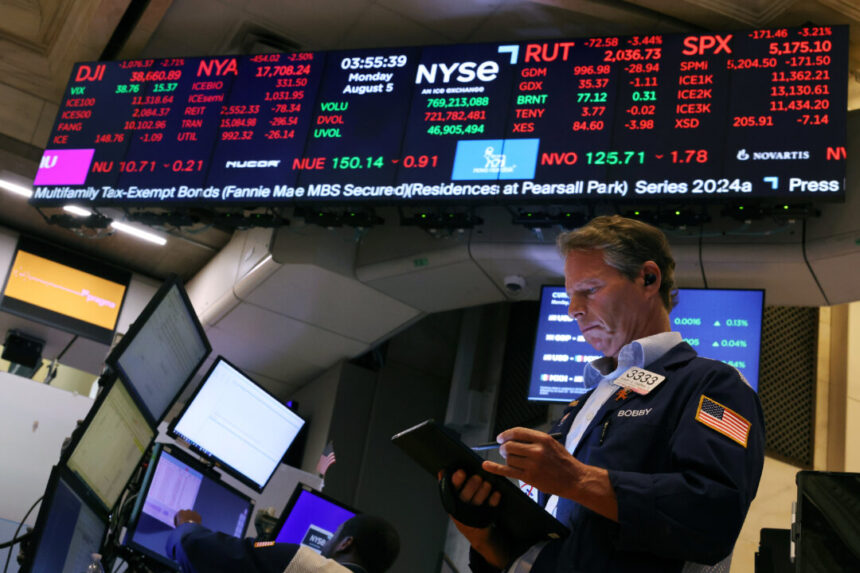Rate cuts alone may not be sufficient to push markets to new all-time highs. The key lies in money supply growth and quantitative easing to sustain these valuations.
Recent market weakness can be attributed to profit-taking, concerns over U.S. economic data, and the abrupt unwinding of the yen carry trade. With valuations at lofty levels, market participants are now calling for central bank easing. However, the reality is that rate cuts may not be enough to propel markets to record highs; what’s needed is an increase in money supply and quantitative easing.
Investors are turning to utilities and real estate stocks for refuge, but these sectors require more than just low interest rates. They need a thriving economy and robust consumer demand, highlighting the potential insufficiency of interest rate adjustments.
While the market remains in a cyclical bullish phase in the long term, it’s crucial to grasp the reasons behind it and acknowledge the surge in volatility.
The current market ascent reflects expectations of a growing money supply and future currency devaluation. Yet, the next phase of central bank easing might not materialize until 2025.
Although fundamentals have been lackluster and earnings not as strong as expected given the high valuations, investors recognize the fiscal challenges posed by escalating government spending and public debt. This recognition ultimately points toward ultra-loose monetary policies that inflate sovereign bond prices, erode currency value, and make equities and risky assets more appealing by comparison.
Investors may be willing to overlook elevated valuations for equities and risky assets due to concerns about monetary and fiscal recklessness overshadowing fears of a potential recession.
Extreme monetary policies that diminish currency purchasing power steer investors toward equities and risky assets as a hedge against actual inflation. The true money supply (TMS) serves as a more realistic gauge of inflation, emphasizing the significance of liquidity in market transactions.
Analysts like Mike Shedlock delve into the nuances of money growth, shedding light on the buying and selling pressures within the market. The TMS encompasses various components that indicate the level of demand for risky assets seeking returns.
Contrary to Keynesian views that deem deposit and savings accounts as idle money, these funds play a vital role in capital markets, fostering lending, investment, and economic growth. Understanding the importance of liquidity and market sentiment derived from a rising TMS can provide insights into the market direction.
Recognizing that market participants prioritize liquidity and sentiment perception underscores the impact of TMS fluctuations on bullish or bearish market signals. This understanding allows for a deeper comprehension of central bank policies and investors’ strategies to safeguard against currency devaluation through higher risk exposure and acceptance of elevated asset valuations.
In essence, the focus on liquidity and sentiment, driven by changes in the TMS, reveals why investors are compelled to embrace riskier assets amid concerns of currency devaluation and fiscal imbalances caused by unsustainable deficit spending. Market corrections present a prime opportunity to invest in stocks and risky assets that are likely to increase in value due to the depreciation of the currency. Understanding the impact of fiscal policies on currency value and market performance is crucial for investors. With persistent inflation and central bank challenges, timing becomes essential in predicting market movements.
Following the Federal Reserve’s decision to maintain interest rates, the market experienced a dip, indicating concerns about liquidity. Despite hints of potential rate cuts in the future, investors remained cautious due to lower buying pressure. The impact of market corrections and subsequent rebounds may take longer to materialize this time around.
To prepare for the next wave of monetary growth, investors should monitor market trends and anticipate potential easing measures by the Fed. While a rate cut may temporarily boost market sentiment, true bullish signals will come from actions like asset purchases by the central bank. It is important to remain vigilant and exercise caution in the current economic environment.
Lessons from previous market corrections highlight the importance of diversification and strategic planning. Defensive assets like gold may offer better protection during market downturns, while risky assets and cryptocurrencies may exhibit higher volatility. Maintaining liquidity to seize opportunities during market fluctuations is key for long-term investment success.
In a volatile economic landscape, staying informed about macroeconomic factors and market trends is crucial for making informed investment decisions. As the next phase of monetary expansion approaches, investors should remain vigilant and adaptable to navigate the evolving financial landscape. Timing and prudence are essential in capitalizing on market opportunities and mitigating risks in an unpredictable market environment.
Please note that the opinions expressed in this article are solely those of the author and do not necessarily reflect the views of The Epoch Times.
Source link





